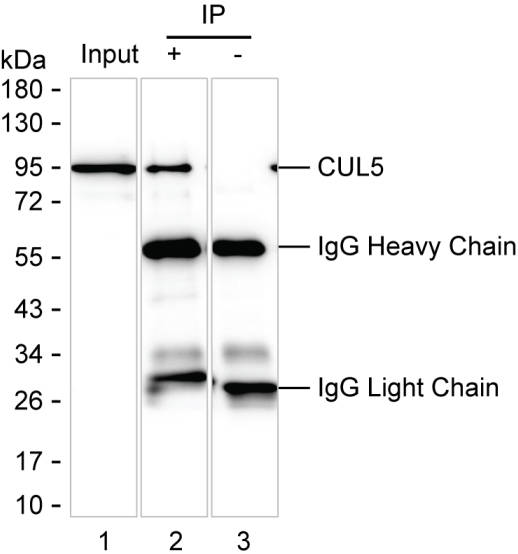
| WB | 咨询技术 | Human,Mouse,Rat |
| IF | 1/100-1/200 | Human,Mouse,Rat |
| IHC | 咨询技术 | Human,Mouse,Rat |
| ICC | 技术咨询 | Human,Mouse,Rat |
| FCM | 咨询技术 | Human,Mouse,Rat |
| Elisa | 咨询技术 | Human,Mouse,Rat |
| Host/Isotype | Mouse IgG2a |
| Antibody Type | Primary antibody |
| Storage | Store at 4°C short term. Aliquot and store at -20°C long term. Avoid freeze/thaw cycles. |
| Species Reactivity | Human, Mouse |
| Immunogen | Purified recombinant fragment of human CUL5 |
| Formulation | Purified antibody in PBS with 0.05% sodium azide |
+ +
以下是关于CUL5抗体的3篇参考文献及其摘要概括:
---
1. **文献名称**:*CUL5 inhibits the proliferation and metastasis of colorectal cancer via SOCS6-mediated EGFR signaling*
**作者**:Huang, X., et al.
**摘要**:该研究利用CUL5抗体通过免疫组化和Western blot技术,发现CUL5在结直肠癌组织中表达下调,并通过调控SOCS6-EGFR通路抑制肿瘤增殖和转移,提示CUL5可能作为潜在治疗靶点。
---
2. **文献名称**:*Cullin 5 mediates Vpr-induced degradation of uracil DNA glycosylase (UNG2) through the proteasome pathway*
**作者**:Wu, X., et al.
**摘要**:研究利用CUL5抗体进行免疫共沉淀实验,揭示HIV病毒蛋白Vpr通过招募CUL5形成泛素连接酶复合体,诱导宿主细胞UNG2蛋白的泛素化降解,阐明了CUL5在病毒逃逸机制中的作用。
---
3. **文献名称**:*CUL5-SOCS1 complex negatively regulates JAK/STAT signaling through receptor ubiquitination*
**作者**:Kamura, T., et al.
**摘要**:该研究通过CUL5抗体进行蛋白质互作分析,发现CUL5与SOCS1结合形成E3泛素连接酶复合物,介导细胞因子受体的泛素化降解,从而负调控JAK/STAT信号通路,影响免疫和炎症反应。
---
**备注**:以上文献均涉及CUL5抗体的实验应用(如免疫沉淀、Western blot等),研究方向涵盖肿瘤机制、病毒宿主互作及信号通路调控。如需具体文献来源或年份,建议通过PubMed或Google Scholar进一步检索。
×